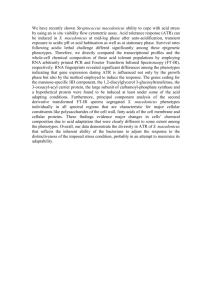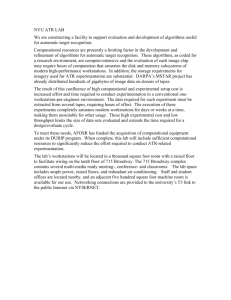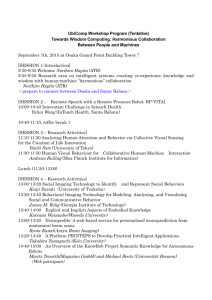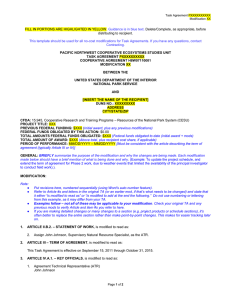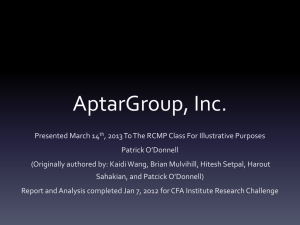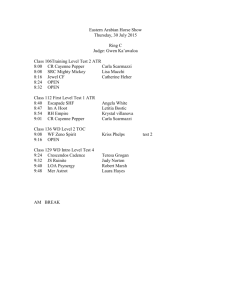ATR Users Manual
advertisement
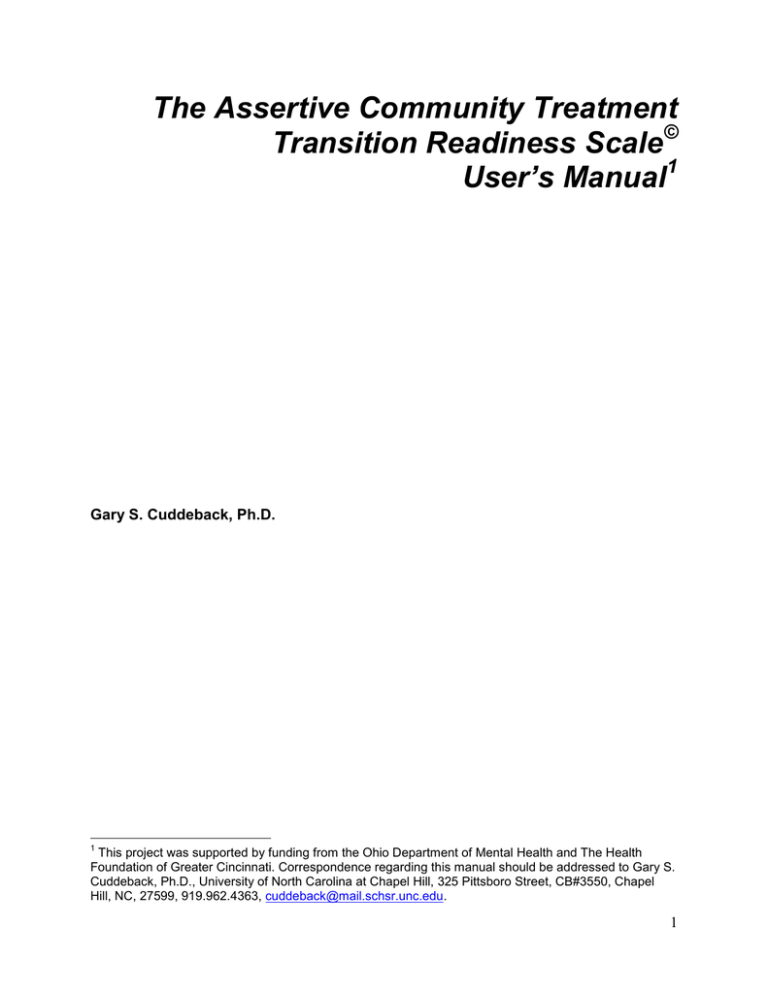
The Assertive Community Treatment Transition Readiness Scale© User’s Manual1 Gary S. Cuddeback, Ph.D. 1 This project was supported by funding from the Ohio Department of Mental Health and The Health Foundation of Greater Cincinnati. Correspondence regarding this manual should be addressed to Gary S. Cuddeback, Ph.D., University of North Carolina at Chapel Hill, 325 Pittsboro Street, CB#3550, Chapel Hill, NC, 27599, 919.962.4363, cuddeback@mail.schsr.unc.edu. 1 TABLE OF CONTENTS Chapter 1: Introduction Chapter Overview Definition of Terms Literature Review The Need for Standardized Measure to Assess Transition Readiness Development of the ATR© Consumer Characteristics Assessed by the ATR© Advantages of Using the ATR© What the ATR© Should Not Be Used For 3 3 3 3 4 5 5 5 6 Chapter 2: Scoring and Interpreting the ATR Chapter Overview Scoring the ATR© Reverse-scored Items Missing Item Responses ATR© Scores Total Scores Mean Scores Cutoff Scores 7 7 7 7 8 8 8 8 8 Chapter 3: Administration and Use Chapter Overview When to Complete the ATR© How to Complete the ATR© Using the ATR© 10 10 10 10 10 2 CHAPTER 1: INTRODUCTION Chapter Overview This is the user’s manual for the Assertive Community Treatment Transition Readiness Scale©, or ATR©, for short. It is highly recommended that you read this manual carefully and thoroughly before using the ATR©. The ATR© is an 18-item paper-and-pencil measure that was developed to help assertive community treatment (ACT) teams identify ACT consumers who might be ready to transition from ACT to less intensive services. In this Chapter, I will provide a brief overview of the published research literature about transitions from ACT. Next, I will discuss the importance of and need for standardized measures to help ACT teams identify consumers who might be ready to transition to less intensive services. Then, I will briefly describe the development of the ATR©. Next, I will discuss some of the advantages of using the ATR©. I will conclude Chapter 1 with a discussion of how the ATR© should not be used. First, I will begin by introducing key terms that will be used throughout this manual. Definition of Terms A number of key terms will be used throughout this manual. These are defined below. Assertive Community Treatment – ACT is an evidence-based practice for persons with severe and persistent mental illness. ACT staff – ACT staff members can include but are not limited to case managers, social workers, therapists, nurses, psychiatrists, substance abuse specialists, housing specialists, benefit specialists, and peer support specialists. ACT consumer – ACT consumer refers to persons with severe and persistent mental illness who are receiving ACT services. Transition – Transition refers to a planned transition from ACT to less intensive services. Transition readiness – Transition readiness refers to the potential for an ACT consumer to transition from ACT to less intensive services without experiencing deterioration in functioning or undesirable outcomes, such as hospitalization or incarceration. Less intensive services – The term less intensive services is used throughout this manual to describe services that are less intense and/or frequent than ACT. These services may be called usual care, traditional case management, or community support in your community. Literature Review Assertive community treatment (ACT) is an evidence-based practice for persons with severe and persistent mental illness and is characterized as a multi-disciplinary, team-based approach with a small (1:10) staff-consumer ratio, 24/7 hour availability, aggressive outreach and engagement, which delivers a wide array of psychosocial interventions. 2 ACT targets the most profoundly ill among persons with severe mental illness and it was originally conceptualized that those who needed ACT would need ACT for life. 3 However, this ACT-for-life perspective is 2 Bond, G. R., Drake, R. E., Mueser, K. T., & Latimer, E. (2001). Assertive community treatment for people with severe mental illness: Critical ingredients and impact on patients. Disease Management & Health Outcomes, 9(3), 141-159. 3 Stein, L. I., & Test, M. A. (1980). Alternative to mental hospital treatment. Archives of General Psychiatry, 37, 392-397. 3 contrary to what we know today about recovery from mental illness and presents a considerable challenge because once a team reaches capacity it is no longer a resource to the community. 4,5 This is a significant problem because in most communities ACT capacity does not meet demand and many persons who could benefit from ACT are denied access. 6 Many teams solve this capacity-demand problem by transitioning consumers to less intensive services. Only a handful of studies have examined the transitions of persons with severe mental illness from ACT to less intensive services. Several experimental studies suggest consumers should not be transitioned from ACT. For example, in Stein and Test’s original study of ACT, within 14 months of transition to usual care former ACT consumers who were randomly assigned to transition to less intensive services had reverted to their pre-ACT functioning and hospitalization patterns. 7 Another study found a 67% increase in hospital days among consumers who were randomly assigned to be transitioned to standard case management. A third study found an increase in hospitalizations and loss in clinical gains among consumers who were randomly selected to have intensive home-based, ACT-like care withdrawn. 8,9 Other studies, albeit with weaker designs, suggest ACT consumers can be transitioned to less intensive services. For example, in a retrospective record review, transitioned ACT consumers had better outcomes compared to consumers who were not transitioned; however, those who were transitioned were higher functioning prior to transition than those who remained on ACT. 10 Further, two quasi-experimental studies compared housing outcomes among consumers who received time-limited intensive case management and consumers who received usual care and found that time-limited intensive case management had sustained effects on housing; however, effects on hospitalizations and other indicators were omitted. 11,12 The Need for Standardized Measures to Assess Transition Readiness The evidence about transitions from ACT to less intensive services is mixed and a number of gaps in our knowledge remain, including a clear understanding of who can transition to less intensive services, to what level of less intensive services and with what outcomes. Moreover, 4 Davidson, L. (2003). Living outside mental illness: qualitative studies of recovery in schizophrenia. New York: New York University Press. 5 Anthony, W. (1993). Recovery from mental illness: The guiding vision of the mental health service system in the 1990s. Psychosocial Rehabilitation Journal, 16(4), 11-23. 6 Cuddeback, G. S., Morrissey, J. P., & Meyer, P. S. (2006). How many ACT teams do we need? Results from a large, urban community. Psychiatric Services, 57(12), 1803-1806. 7 Stein, L. I., & Test, M. A. (1980). Alternative to mental hospital treatment. Archives of General Psychiatry, 37, 392-397. 8 Audini, B., Marks, M., Lawrence, R.E., Connolly, J., & Watts, V. (1994). Home-based versus outpatient/in-patient care for people with serious mental illness: Phase II of a controlled study. British Journal of Psychiatry, 165, 204–210. 9 McRae, J., Higgins, M., Lycan, C., & Sherman, M. D. (1990). What happens to patients after five years of intensive case management stops? Hospital and Community Psychiatry, 41(2), 175-179. 10 Salyers, M. P., Masterston, T. W., Fekete, D. M., Picone, J. J., & Bond, G. R. (1998). Transferring clients from intensive case management: Impact on client functioning. American Journal of Orthopsychiatry, 68(2), 233-245. 11 Jones, K., Colson, P. W., Holter, M. C., Lin, S., Valencia, E., Susser, E., & Wyatt, R. J. (2003). Costeffectiveness of critical time intervention to reduce homelessness among persons with mental illness. Psychiatric Services, 54(6), 884-890. 12 Susser, E., Valenica, E., Conover, S., Felix, A., Wei-Yann, T., & Wyatt, R. J. (1997). Preventing recurrent homelessness among mentally ill men: A “critical time” intervention after discharge from a shelter. American Journal of Public Health, 87(2), 356-262. 4 there are no standardized measures designed specifically to help ACT teams identify consumers who might be ready to transition from ACT to less intensive services. This is particularly problematic given the focus on increased access to evidence-based practices in the public mental health system. 13 The lack of standardized measures designed specifically to help ACT teams identify consumers who might be ready to transition to less intensive services is a critical barrier to progress in mental health practice, policy, and research. Here, to address this critical gap in mental health practice, policy and research, the Assertive Community Treatment Transition Readiness Scale© (ATR©) has been developed. Development of the ATR© The ATR© is an 18-item, paper-and-pencil measure designed to help ACT staff identify ACT consumers who might be ready to transition to less intensive services. In developing the items for the ATR©, several sources for item content were identified: (a) qualitative interviews with experienced ACT staff, (b) research on ACT transitions, and (c) similar standardized measures such as the Level of Care Utilization System for Psychiatric and Addiction Services (LOCUS). 14 Consumer Characteristics Assessed by the ATR© Care was given to constructing items on the ATR© using principles of good item construction and to writing clear instructions for completion. 15 Items were written to cover the following areas: (a) psychiatric and behavioral stability; (b) hospitalization and incarceration; (c) housing stability; (d) treatment engagement; (e) medication compliance; (g) independence; (g) complexity of health and behavioral issues, including substance abuse; (h) intensity of service need; (i) benefits; (j) social support; (k) resources; (l) insight; (m) daily structure; and (n) employment. Advantages of Using the ATR© There are a number of advantages to using standardized measures like the ATR© along with clinical judgment and other decision-making methods. Clinical wisdom and professional judgment should and always will be an important part of identifying consumers who are ready to transition from ACT to less intensive services. However, clinical wisdom and professional judgment can be used along with high quality standardized measures to improve assessments of a consumer’s readiness to transition. The intent here is not to replace clinical judgment but to improve clinical judgment with the addition of the ATR©. The ATR© has the potential to formalize and codify the transition decision-making process by providing guidance to ACT teams concerning relevant information to consider about transitions to less intensive services, and this could be particularly important for new and/or inexperienced ACT teams and staff members. Further, a standardized measure such as the ATR© has the potential to reduce subjectivity and bias inherent in clinical judgment and practice wisdom. Also, the ATR© can facilitate communication and accountability among staff within teams and between teams and their agencies through quantitative information that can be incorporated into 13 New Freedom Commission on Mental Health, Achieving the Promise: Transforming Mental Health Care in America. Final Report. DHHS Pub. No. SMA-03-3832. Rockville, MD: 2003. 14 Sowers, W., George, C., & Thompson, K. (1999). Level of Care Utilization System for Psychiatric and Addiction Services (LOCUS): A preliminary assessment of reliability and validity. Community Mental Health Journal, 35(6), 545-563. 15 Nunnally, J. C., & Bernstein, I. H. (2001). Psychometric theory (4th ed.). New York: McGraw-Hill. 5 assessments and reports. The ATR© could be used as a clinical tool for consumer progress and case planning purposes and as an administrative and/or supervisory tool to focus treatment goals and monitor ACT team performance. Also, scores on the ATR© can be used by agencies and by local and state mental health authorities to develop standards about transitioning consumers from ACT. Finally, standardized measures like the ATR©, save money and time, relative to subjective evaluations, especially when they require little training or effort to use. 16 What the ATR© Should Not Be Used for The ATR© should not be used as the sole method with which transition decisions are made. The ATR© should be used in concert with clinical judgment and other assessment methods to identify consumers who might be ready to transition from ACT to less intensive services. Most importantly, the ATR© should not be used for purposes for which it was not intended. For example, the ATR© should not be used to determine if a consumer needs to be hospitalized. 16 Nunnally, J. C., & Bernstein, I. H. (2001). Psychometric theory (4th ed.). New York: McGraw-Hill. 6 CHAPTER 2: ATR© SCORING AND INTERPRETATION Chapter Overview Chapter 2 focuses on scoring and interpreting the ATR©. In this Chapter, I will provide instructions about how to score the ATR©. Next, I will provide guidelines about missing data and reverse-scoring items on the ATR©. Then, I will discuss ATR© total and Mean scores. I will conclude this section with a discussion of cutoff scores for the ATR©. Scoring the ATR© The ATR© is an 18-item measure designed to assess the readiness of ACT consumers to transition from ACT to less intensive services. The 18 items cover the following areas: • • • • • • • • • • • • • • psychiatric and behavioral stability; hospitalization and incarceration; housing stability; treatment engagement; medication compliance; independence; complexity of health and behavioral issues; intensity of service need; benefits; social support; resources; insight; daily structure; and employment. Each item is scored on a four-point response scale: strongly disagree (1), disagree (2), agree (3), strongly agree (4). For example, Item 1 reads, “He/she no longer needs intensive services.” If you strongly agree with this statement about the ACT consumer you are assessing, the consumer would receive a score of 4. If you strongly disagree with the statement, indicating the consumer still needs intensive services, the consumer would receive a score of 1 for this item. You will be provided instructions for computing Total and Mean scores later. Reverse-scored items Before computing Total or Mean scores, for each ACT consumer’s score the responses to four items must be reverse-scored, so that for each item a higher score indicates greater potential to transition from ACT to less intensive services. As stated above, when you complete the ATR© on a consumer, you will be asked to rate each consumer on a series of questions using a 4-point response scale: strongly disagree (1), disagree (2), agree (3), strongly agree (4). The items that need to be reverse-scored are as follows: • • Item 5 – He/she has been in the psychiatric hospital within the last six months. Item 7 – He/she has been incarcerated within the last six months. 7 • • Item 12 – He/she has complex needs (i.e., personality disorders, health problems, substance use). Item 17 – His/her behaviors have not been stable over the last six months. For example, if you respond strongly disagree (1) on item 5 for a particular consumer, this response should be reverse scored to 4 before computing a consumer’s total score or Mean. If you respond strongly agree (4) to Item 12, “He/she has complex needs (i.e., personality disorders, health problems, substance use,” you would reverse score the item to a 1 before computing a consumer’s total score or Mean. Missing Item Responses A Total or Mean score on the ATR© should not be computed if fewer than 80% of the items are completed. That is, at least 14 of the 18 items must be completed before scoring the ATR©. ATR© Scores Higher scores on the ATR© indicate greater potential to transition from ACT to less intensive services. Total scores or Mean scores for the ATR© can be computed. Total scores are the sum of all item responses on a measure and Mean scores are the average of all item responses. Be sure to reverse-score items 5, 7, 12, and 17 before computing Total or Mean scores! Total Scores: A Total score on the ATR© can be computed by adding up all of the item responses. Total scores on the ATR© can range from 18 to 72, with higher scores indicating greater potential to transition from ACT to less intensive services. Be sure to reverse-score items 5, 7, 12, and 17 first! An example of a simple EXCEL spreadsheet has been provided below. Please contact me if you would like a copy of this program or if you would like help in designing your own scoring and data collection program. Mean Scores: The Mean score on the ATR© can be computed by adding up item responses and dividing by the number of completed items. The Mean score can range from 1.0 to 4.0. A simple scoring sheet can be created in EXCEL. If this were a working spreadsheet I would simply enter scores under each item for Items Q1 – Q18. The spreadsheet can be programmed to alert you when you enter a score outside the allowable response range (i.e., 1, 2, 3, or 4). Note that item 4 is beyond the allowable range and the cell is highlighted in red. Be sure to reverse-score items 5, 7, 12, and 17 first! The spreadsheet can be programmed to automatically calculate Total and Mean scores. ID Q1 Q2 Q3 Q4 Q5 Q6 Q7 Q8 Q9 Q10 Q11 Q12 Q13 Q14 Q15 Q16 Q17 Q18 1234567 2 1 3 6 3 4 1 2 1 2 4 4 3 3 2 1 1 4 Total Score 47 Average Score 2.61 Cutoff Scores: In an effort to help ACT teams use the ATR© to help make decisions about ACT consumers who might be ready to transition to less intensive services, cutoff scores were developed. More information about how this was done will be covered in a Technical Manual 8 which will be forthcoming soon. Cutoff scores should only be used as rough guides rather than definitive, set-in-stone rules for making transition decisions. In this context, consumers with Total scores on the ATR© equal to or greater than 50 could be considered candidates for transition from ACT to less intensive services. Similarly, consumers with Mean scores of equal to or greater than 2.8 could be considered for transition from ACT to less intensive services. Measures such as the ATR© never do a perfect job of predicting whatever they are intended to predict. So, as with any measure, there is some amount of inherent measurement error and with any cutoff score there are occasions where misclassification will occur. Ideally, a measure should maximize true positives (i.e., correctly identify consumers who have the potential to transition when they truly) while minimizing false positives (i.e., incorrectly identify consumers as having the potential to transition when they do not). Using the cutoff scores listed above will correctly identify about 75% of your consumers as having the potential to transition when they do but will misidentify about 22% of your consumers as having the potential when they do not. That is why it is important to remember that the ATR© is to be used along with clinical judgment, practice wisdom and other resources to make decisions about transitioning consumers. As stated earlier, these cutoffs are only to be used as rough guidelines. For example, if a consumer has a total score of 25 of 72 on the ATR, he or she might not be a good candidate for transition. If a consumer has a score of a 68 of 72 on the ATR©, he or she might be a good candidate for transition. The further a consumer’s score is from these cutoffs the easier it might be to assess readiness for transition; however, the closer a consumer’s score is to the cutoffs the more challenging it might be to make a transition decision. Again, these cutoffs are rough guidelines and the ATR© should not be the only method used to help make transition decisions. 9 CHAPTER 3: ADMINISTRATION AND USE Chapter Overview Chapter 3 focuses on the administration and use of the ATR©. In this Chapter, I discuss guidelines for when to complete the ATR©. Then, I will discuss how to complete the ATR©. I will conclude with a discussion of how to use the ATR©. When to Complete the ATR© The ATR© was intended to be used as a tool to help identify consumers who might be ready to transition from ACT to less intensive services. This implies that the ATR© can be used with a consumer who has been receiving ACT services for some time, who is stable, and who could handle transition to less intensive services, which was the original intent. However, there may be other uses for the ATR©. For example, the ATR© could be used as a clinical tool to assess and monitor consumer progress. Thus, the ATR© could be used during the ACT intake process and re-administered periodically (i.e., every six months). How to Complete the ATR© Currently, only a staff version of the ATR© exists. That it, the ATR© is a measure completed by an ACT staff member on an ACT consumer. There are 18 items on the ATR©. Each item should be read carefully before answering. The ATR© can be completed by an individual ACT staff member or as a team. The original intent for the ATR© was that it was to be completed without the presence of the consumer; however, you or your agency might choose to do this differently. Currently, only a paper-and-pencil version of the ATR© exists (see below). Using the ATR© The ATR© is a work in progress. So far, the ATR© appears to have excellent reliability and good concurrent and predictive validity. However, the ATR© has only been tested retrospectively. More testing of the ATR© is needed! The ATR© is free to use and you can use it as much and as often as you like. I would be interested in hearing from you if you or your agency decides to use the ATR©. In particular, if your team or agency decides to adopt the ATR© as a part of your routine assessment strategy, I would like to talk to you about how you might collect your data and how your data could be useful to further testing the ATR©. And, I would be very interested in hearing your feedback about the ATR©, particularly your likes and dislikes and suggestions for improvement. Also, if you have further questions about the ATR© or if you’re interested in the Technical Manual, please feel free to contact me. THANKS! 10 © © This is the Assertive Community Treatment Transition Readiness Scale (ATR ). Each item is scored on a four-point scale: strongly disagree (1), disagree (2), agree (3), strongly agree (4). For example, Item 1 reads, “He/she no longer needs intensive services.” If you strongly agree with this statement, a consumer would receive a score of 4 for this item. Before computing Total or Mean scores, the responses to Items 5, 7, 12, and 17 must be reverse-scored. So, if you respond strongly disagree (1) to Item 5, this response should be reverse-scored to 4 before computing Total or © Mean scores. At least 14 of the 18 items must be completed before scoring the ATR . A Total score can be computed by adding up all item responses. Total scores range from 18 to 72. Mean scores can be computed by adding up all item responses and dividing by the number of completed items. Mean scores range from 1.0 to 4.0. Higher Total and Mean scores indicate greater potential to transition from ACT to less intensive services. © Questions about the ATR should be addressed to Gary S. Cuddeback, Ph.D., University of North Carolina at Chapel Hill, 325 Pittsboro Street, CB#3550, Chapel Hill, NC, 27599, 919.962.4363, cuddeback@mail.schsr.unc.edu. NAME_______________________________ DATE _________________ TOTAL or MEAN SCORE ______________ Strongly Disagree 1. He/she no longer needs intensive services. 2. He/she has structure in his/her daily life. 3. His/her symptoms have been stable over the last six months. 4. He/she has had stable housing over the last several months. 5. He/she has been in the psychiatric hospital within the last six months. 6. He/she has insight into his/her mental illness. 7. He/she has been incarcerated within the last six months. 8. He/she has benefits in place. 9. Disagree Agree Strongly Agree He/she is engaged in treatment. 10. He/she is independent. 11. He/she is compliant with his/her medication. 12. He/she has complex needs (i.e., personality disorders, health problems, substance use). 13. He/she has adequate resources. 14. He/she has social support. 15. He/she is gainfully employed. 16. He/she keeps appointments without help. 17. His/her behaviors have not been stable over the last six months. 18. He/she has met his/her treatment goals. 11
